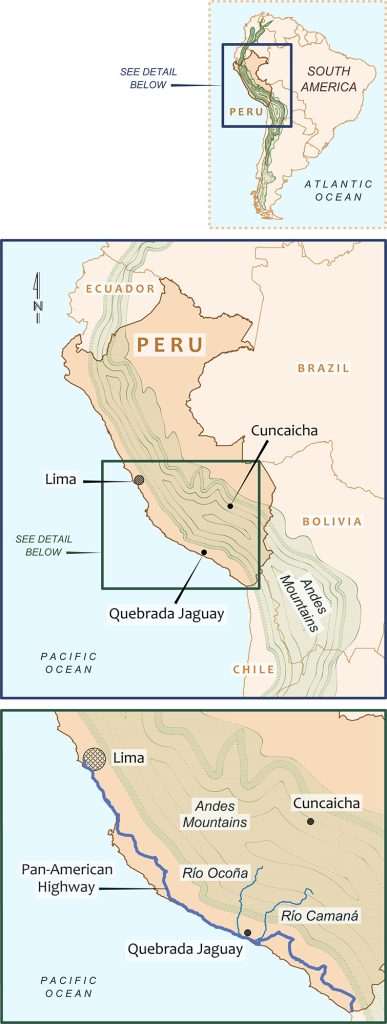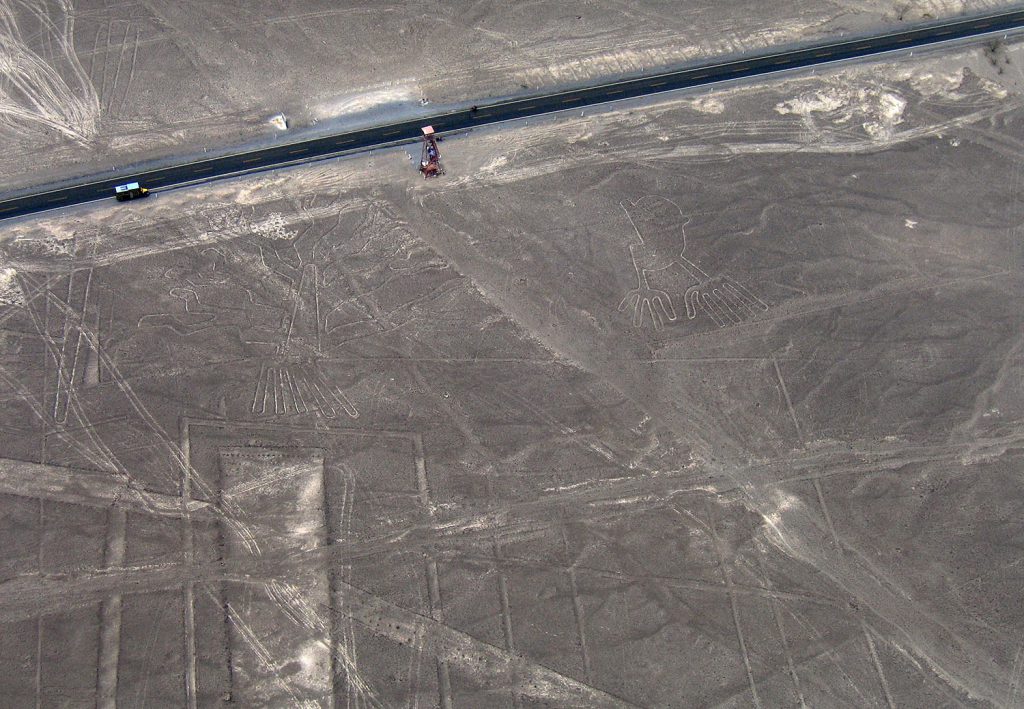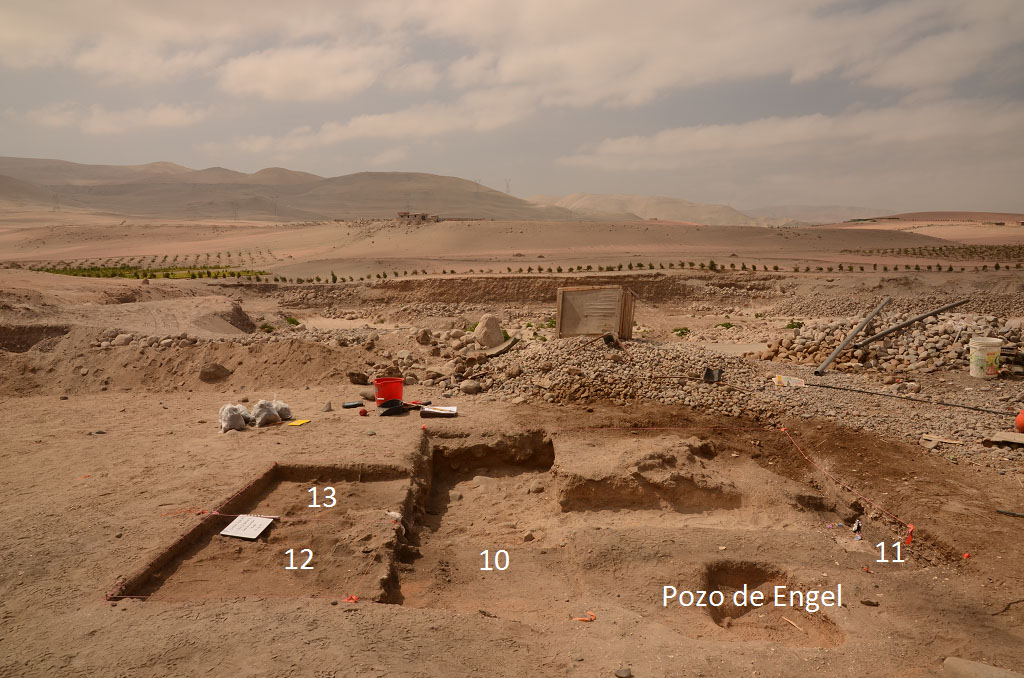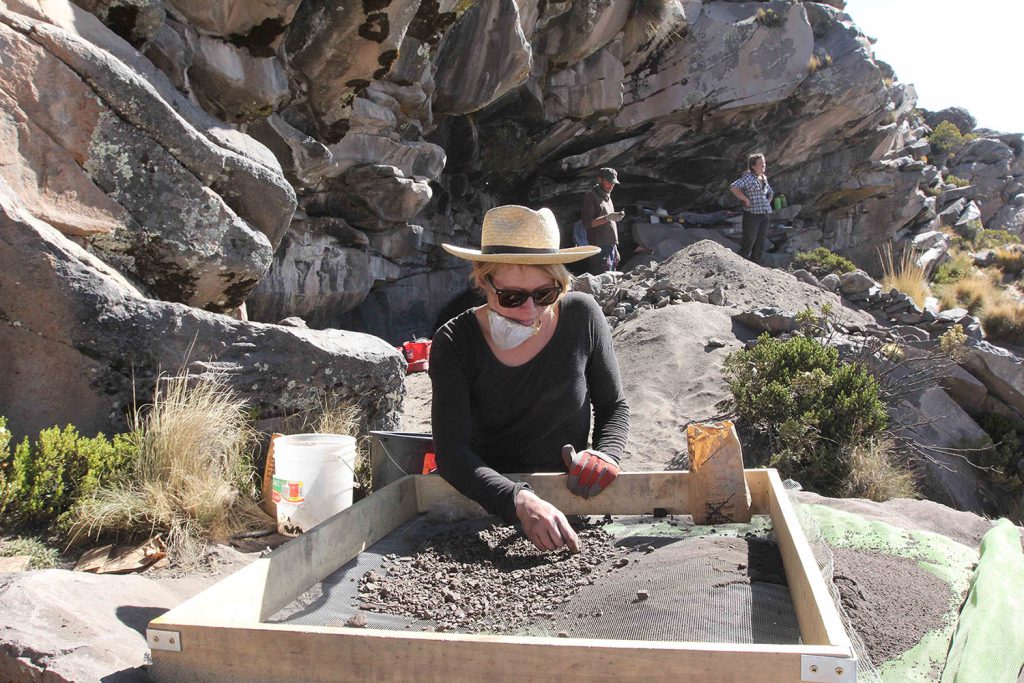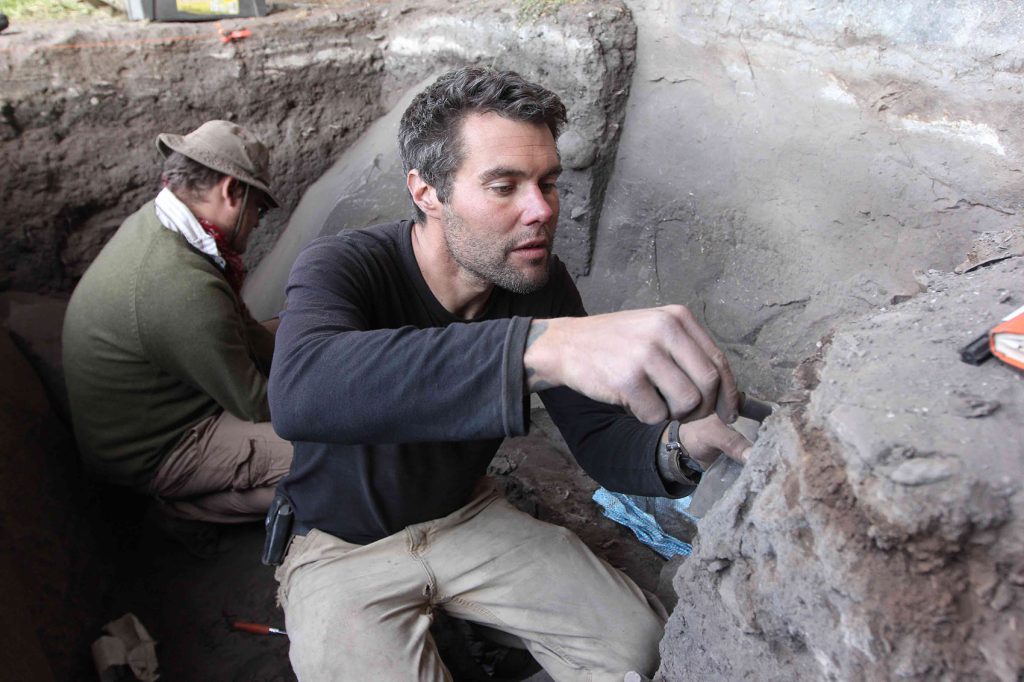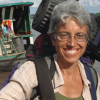The Race to Recover South America’s Ancient Past
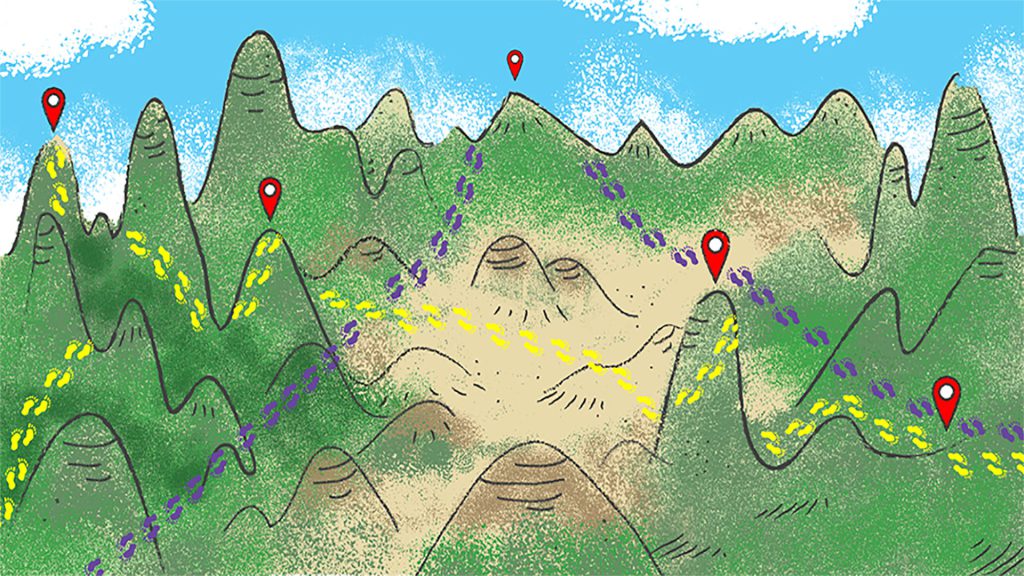
Archaeologist Kurt Rademaker feared his field season was over before it had even begun. It was July 2017, and he was scanning Quebrada Jaguay, a desert site on the southern Peruvian coast. The site lay along a streambed between the Ocoña and Camaná rivers surrounded by sand and within sight of the craggy, arid foothills of the Andes Mountains. Despite its barren appearance, the location was home to some of the earliest inhabitants of South America millennia ago.
In the 1990s, archaeologist Daniel Sandweiss of the University of Maine had studied the site. But although Rademaker was equipped with records of those excavations, it was barely recognizable. Part of the area had been bulldozed to extract sand and gravel for road building, and the ground was crisscrossed with tire tracks. Sandweiss’ records indicated that the site was shallow, with prehistoric artifacts and ancient remains less than half a meter deep. Because of the disturbance, Rademaker and his team feared there was nothing left.
“I had a minor heart attack,” says Rademaker, of Northern Illinois University. He wondered, “Should I send all the students home? What’s going to happen to the project?”
After poring over satellite images and using a drone to survey and photograph the site, the team discovered that the situation was not as dire as it had seemed. With images and help from Sandweiss, who accompanied Rademaker, the team located the earlier excavations. Nonetheless, “much of the site had been destroyed, which was very sad,” Sandweiss says.
The conditions at Quebrada Jaguay are not atypical. Years of gradual economic development and population growth have spurred road construction, agricultural expansion, and urban sprawl across South America. These changes, along with natural phenomena such as sea-level rise and erosion, now threaten to obliterate clues to some of the continent’s earliest human settlements.
But a new generation of archaeologists is joining the race against this destruction, reexamining sites that were first excavated decades ago and seeking new ones before they vanish. The effort is both multigenerational and multidisciplinary. Researchers who launched their careers excavating sites in Peru as long ago as the 1960s and 1970s are passing their notes and knowledge on to younger colleagues who are taking a fresh look with tools drawn from computer modeling, geophysics, genomics, paleoenvironmental studies, and climate reconstructions.
Although these sites lack the gold and splendor of artifacts from more recent cultures, they offer precious insights into who we are and how we got here. Little is known about the earliest inhabitants of South America. They may have crossed the Mesoamerican isthmus or traveled by sea along the coast.
When humans first traversed from one side of the formidable Andean range to the other remains a mystery. And questions about how they used their environment continue to puzzle researchers: What resources did these people find and adapt in places as apparently inhospitable as the desert coasts of Peru and Chile, the rarefied atmosphere of the high Andes, or the southern portion of Patagonia, with its arid climate and bitterly cold winters? Answering these questions can help us appreciate the ingenuity and survival abilities of these rugged people.
Although it is still too soon to draw conclusions, there is tantalizing evidence that people occupied sites in South America between 12,000 and 14,500 years ago—or possibly even earlier. The oldest sites imply that humans may have dispersed throughout the continent earlier and more rapidly than was generally believed. These ancients lived not only along the South American coast but also at high altitudes, where lower oxygen levels and wide daily temperature swings were long assumed by researchers to have made the environment too hostile for early human habitation.
As archaeologists identify and connect these sites, they hope to unravel patterns of the earliest human activity on the continent.
Not long ago, conventional wisdom held that people who crossed into North America from Asia did not begin to spread southward before about 13,500 years ago. That timing, toward the end of the last ice age, or near the close of the late Pleistocene period, coincides with the so-called Clovis culture, named for a site in New Mexico that yielded distinctive spear points. For decades, all evidence suggested that the people who made Clovis points were the earliest inhabitants of the Americas. Researchers therefore expected sites in South America to be considerably younger.
But in the 1970s and 1980s, anthropologist Tom Dillehay of Vanderbilt University dated Monte Verde, in southern Chile between the Andean foothills and the coastal fjords, to about 14,500 years ago. He faced resistance, but as archaeologists found other late Pleistocene sites in North and South America, a growing number of researchers began to question whether Clovis points really represented the earliest humans in the Americas. Debate has raged in the field for decades, with researchers contesting the age of various ancient habitations.
Newer studies indicate that people may have crossed from Asia into the Americas as early as 16,000 years ago, possibly traveling southward along the seaward edge of the Cordilleran ice sheet in western North America. That would make earlier dates in South America possible, but mysteries remain: What routes did people follow once they arrived in South America, and how did they spread throughout the continent so rapidly?
“People either moved along the coast and then went inland, moved along the highlands and then to the coast, or both,” Sandweiss says. The trouble, he adds, is that there are too few sites to determine which path they took: “We don’t have a way to specifically connect people to sites, [from] coast to highlands or coast to coast, and to know who went from where to where. We don’t have a lot of dots to connect.”
By combining archaeology, geology, paleoenvironmental studies, and other specialties, Sandweiss, Rademaker, and others hope to piece together how ancient people used the resources at hand in known sites. That information, in turn, could offer hints as to how people moved across the landscape. Studying the sites identified so far could therefore help researchers understand where they are most likely to find new ones. That makes preserving the earliest sites vital, and the task is gaining added urgency as contemporary human activity alters the landscape. Throughout South America, development, road building, and economic activities that have helped increase the gross domestic product and reduce poverty have also threatened or destroyed evidence of occupation from the late Pleistocene, often accidentally.
In Peru, migration from rural areas to cities has caused urban sprawl in coastal river valleys that were probably as attractive to late Pleistocene inhabitants as they are to people today. Peru has also developed an export agricultural industry along the coast, turning the desert green. The cultivation and irrigation projects that allowed for this industry may have disturbed or destroyed sites, as construction of the nearby Pan-American Highway, the country’s key north-south trade and transport route, has done.
In many respects, Peru’s dilemma is a global one. Around the world, human development is threatening ruins and artifacts. In China and Turkey, for example, dams have swallowed up archaeological landscapes. In the United States, the recent Dakota Access pipeline destroyed some graves and sacred places of Native Americans.
In South America, when construction projects expose vestiges of the earliest human activity, many people do not recognize their archaeological value, Dillehay says. He has seen likely sites in the Andean foothills on Peru’s northern coast disappear, paved over as the country’s road system extends farther into rural areas. But even in cases where they are identified, it can be difficult to persuade people of the importance of preservation in the face of constant pressure for development that can boost a nation’s economy and growth.
Past and present climate change has also taken a toll on these ancient sites. At a place called Huaca Prieta, near the city of Trujillo, Dillehay is excavating a late Pleistocene site where evidence of early occupation may lie not only underground but also underwater. Surrounded by wetlands and scrubby vegetation, Huaca Prieta is just a stone’s throw from the Pacific Ocean. When it was initially occupied, however, the shoreline would have been as much as 15 kilometers farther west, situating Huaca Prieta midway between the ocean and the Andean foothills. After the last ice age, melting ice sheets caused sea levels to rise, obliterating any sites close to the shore along this part of the coast, where the shelf drops off gradually toward the sea.
In Chile, where Dillehay also works, glaciers are retreating, exposing sites where organic material that has been preserved under ice may dry up, decay, and disappear, or where newly exposed sites could erode. “The combination of all these factors and the invisibility of these sites underground often leads to destruction, probably at a rate and a volume that we’re not even aware of,” he says.
At Quebrada Jaguay, Rademaker and his team were determined to make the most of the damaged site. Marking off two areas, they set to work at a painstaking pace, excavating 1-centimeter-deep layers and keeping an eye out for any clues about the people who once lived there. With late Pleistocene–era sites so scarce, “it’s worth going back even for that tiny amount [of material] because there are still things we can get out of it,” Rademaker says. “Until we find more, going back to [previously excavated] sites is the only option we’ve got.”
Rademaker also has reason to be optimistic about discovering new clues from old sites thanks to technologies his predecessors did not have or could not afford. For example, earlier techniques for radiocarbon dating, which determines a material’s age by measuring the rate of decay of radioactive carbon 14 in a sample, required several grams of wood or charcoal for analysis. A newer dating technique, accelerator mass spectrometry, counts the number of carbon 14 atoms in the material, rather than measuring their decay. It requires expensive equipment but can yield more precise dates from even tiny samples of organic material, such as small seeds or bits of plants, which are more likely to have been alive when the site was occupied.
Researchers can now date even inorganic objects, such as stone foundations or fire-cracked hearthstones, by measuring light emitted from energy stored in rock or soil. That technique, known as luminescence dating, can determine the length of time since an object, such as a long-buried piece of pottery, was exposed to high heat or when stones in a wall or foundation were last exposed to sunlight.
And they’ve found that clues to environmental changes are hidden in mollusk shells, which are common at coastal sites like Quebrada Jaguay as well as some locations even farther inland. Analysis of carbon and oxygen isotopes trapped in the shells reveals climate fluctuations and the time of year when the mollusks were harvested, which together help archaeologists determine whether a site was used as a seasonal camp or a year-round home.
Quebrada Jaguay’s most intriguing puzzle, however, is the presence of obsidian: black fragments of volcanic glass that come not from Peru’s coast but from ancient lava flows high in the Andes Mountains. It was in 2007, while tracking the obsidian’s source as a graduate student, that Rademaker found a rock shelter some 4,500 meters above sea level. The find would eventually change the way researchers thought about the earliest inhabitants of South America.
In August 2015, Rademaker stood at the shelter’s mouth and gazed out over the brownish-green plateau below. A stream ran past his team’s campsite, while graceful vicuñas, the camel’s wild Andean relative, grazed in the distance near llamas and alpacas, their domesticated relatives.
Just as Monte Verde forced researchers to rethink the “when” of the early habitation of South America, this rock shelter, called Cuncaicha, has made them reconsider the “where.” Many people thought the high Andes would have been too inhospitable for early inhabitants, but Cuncaicha was occupied between 11,500 and 12,500 years ago, making it the highest inhabited ice age site found anywhere in the world so far.
In August at nearly 4,500 meters above sea level, temperatures plunge below freezing at night, but the researchers were in shirtsleeves by late morning. With a steady supply of water and meat, a low-growing, resin-rich plant called llareta for fuel, and the rock overhang for shelter, the plateau would have been a good place to live, as it is for Quechua-speaking alpaca herders today.
Inside the shelter, geoarchaeologist Christopher Miller, of the University of Tübingen in Germany, carefully sliced blocks out of the walls of a square-sided pit about 1.5 meters deep. A prescient undergraduate mentor had once advised him to take both geology and archaeology courses. Today, he combines those fields on both a macro and a micro scale.
“The first thing I do is walk around the landscape,” Miller says. “I do it a couple of times. A lot about the [paleo] environment and past landscapes you can read from the present landscape.”
Miller studies where sediment in the site came from, how it accumulated, and the microscopic material it contains. By examining cross-sections of the Cuncaicha sediment blocks under a microscope, he found that some grayish-colored material comes from ash created by burning llareta plants, which continue to be plentiful near the shelter. The ash adds to the picture of how people managed to live there off and on over thousands of years. Other clues come from hundreds of bone fragments from the llama-like guanaco, the vicuña, and an Andean deer called taruka.
Not far from the shelter, a prehistoric open-air workshop on the plateau yielded 260 tools. Among these instruments were points and scrapers, some of which were made of obsidian that matched the fragments found at Quebrada Jaguay, the sea-level site some 150 kilometers away. Making that trek on foot was a significant feat, and it raises questions about how flakes from the high plain ended up on the coast. Did a single group of people move up and down the beds of rivers that cut deep gashes into the steep, rocky slopes? Or were there two groups, one living beside the ocean and another high in the mountains, who traded with each other?
“We don’t know,” says Rademaker, who continues to search for pieces of the puzzle. During field expeditions in recent years, he and several colleagues have spent weeks hiking up rivers toward the plateau, looking for promising rock shelters. Inside, they use a ground-penetrating radar device, which sends energy pulses into the earth and records how pulses bounce back. The technology cannot tell them what is underground, but it does indicate the sediment depth. Because deeper deposits are more likely to contain traces of human habitation, ground-penetrating radar can help identify places where excavation would be worthwhile. Cavities formed by rocks, which may signal burial sites, also show up.
So far, the shelters at intermediate elevations that show signs of human habitation date back to about 11,000 years ago. But Rademaker believes there are older sites to be found. Newer technology may tease fresh information from previously excavated sites, enabling researchers to fill in pieces of the puzzle of the region’s early human history.
Cuncaicha was not the first intriguing late Pleistocene discovery in the Andean highlands. Archaeologists and anthropologists excavated a handful of sites in Peru’s Ancash, Junín, and Ayacucho regions between the 1950s and 1970s, but their work was interrupted when Shining Path guerrillas launched a brutal war against government security forces in the 1980s. That conflict left both unfinished fieldwork and unanswered questions.
Archaeologist Thomas Lynch, formerly of Cornell University and now retired, was excavating sites in the Ancash region until he was forced to suspend his work. First a massive earthquake and avalanche hit in 1970, burying the nearby town of Yungay; later, the Shining Path brought his efforts to a halt.
He continues to wonder when early Andean inhabitants stopped traveling and began settling down. Year-round residents gradually would have begun to domesticate plants and animals, and probably developed a system for moving livestock up and down the mountainside with the rhythm of the changing seasons. The sites he studied may have been “used in a systematic, seasonal fashion or simply in an opportunistic and sporadic way,” he says.
Today younger archaeologists hope to pick up where Lynch left off. One of them, Verónica Ortiz, a master’s student in archaeology at the Pontifical Catholic University of Peru in Lima, hopes to unravel when and how people in these areas domesticated llamas and alpacas. Molecular biology may help in these undertakings. Genetic analysis can tease more data out of human remains, animal bones, plant material, and even bits of starch mixed with soil than was possible a decade or more ago, says biologist and archaeologist Lars Fehren-Schmitz from the University of California, Santa Cruz.
Scientists can now sequence “whole genomes of historic and prehistoric individuals,” Fehren-Schmitz says. Such research is painting a more complex picture of how early inhabitants spread throughout the Americas. A recent study indicates that a “founding” group entered North America from Siberia more than 13,000 years ago and then split into northern and southern branches. Those two groups remained separate for several thousand years before merging again. South Americans are related to those merged groups, but whether the mixing occurred before, during, or after migration into the southern continent remains unknown.
A few years ago, Fehren-Schmitz reexamined human remains excavated in the 1950s and 1960s at the Lauricocha rock shelter in the central highlands of Peru. The genetic material among the samples from five individuals was consistent with that found in other studies from the central Andes, supporting the hypothesis that they can be traced back to a common founding group. But there were too few individuals to draw broader conclusions about population dynamics.
“We need to study those few remains that we have from the initial period of human presence in the central Andes to get an idea of what genetic diversity looked like [when the earliest inhabitants arrived],” Fehren-Schmitz says.
Links between those earliest inhabitants and modern South Americans may also be illuminated using similar techniques, although genetic studies have shown that some ancient lineages along the Peruvian coast disappeared around the time Europeans arrived. These analyses support historical accounts of how disease and violence decimated some Native populations.
The techniques are not without pitfalls, however. For one, samples could become contaminated by modern DNA, including that of the excavators. Dillehay says that if he were starting over today at Monte Verde in Chile, he would have his assistants’ DNA sequenced to avoid confusing local workers’ genetic material with that of people who might have been their distant ancestors. At Huaca Prieta, he is taking even more precautions. He has had his genome sequenced for comparison, and he is the only person handling, with gloves, any remains that might be candidates for genetic analysis.
Researchers seeking to mine genetic information from relics recovered in the past face other hurdles. Human, plant, and animal remains from earlier excavations are often difficult to find in collections and may have deteriorated under poor storage conditions.
In a way, the specimens’ fragility echoes the frailty of the places where they were found. “Archaeological sites are sedimentary archives, and they’re a finite resource,” Rademaker says. “If we lose them, we don’t just lose what we can do with them now—we lose what we could ever do with them in the future. And we don’t know how many of them are out there and how many we’ve already lost.”

































